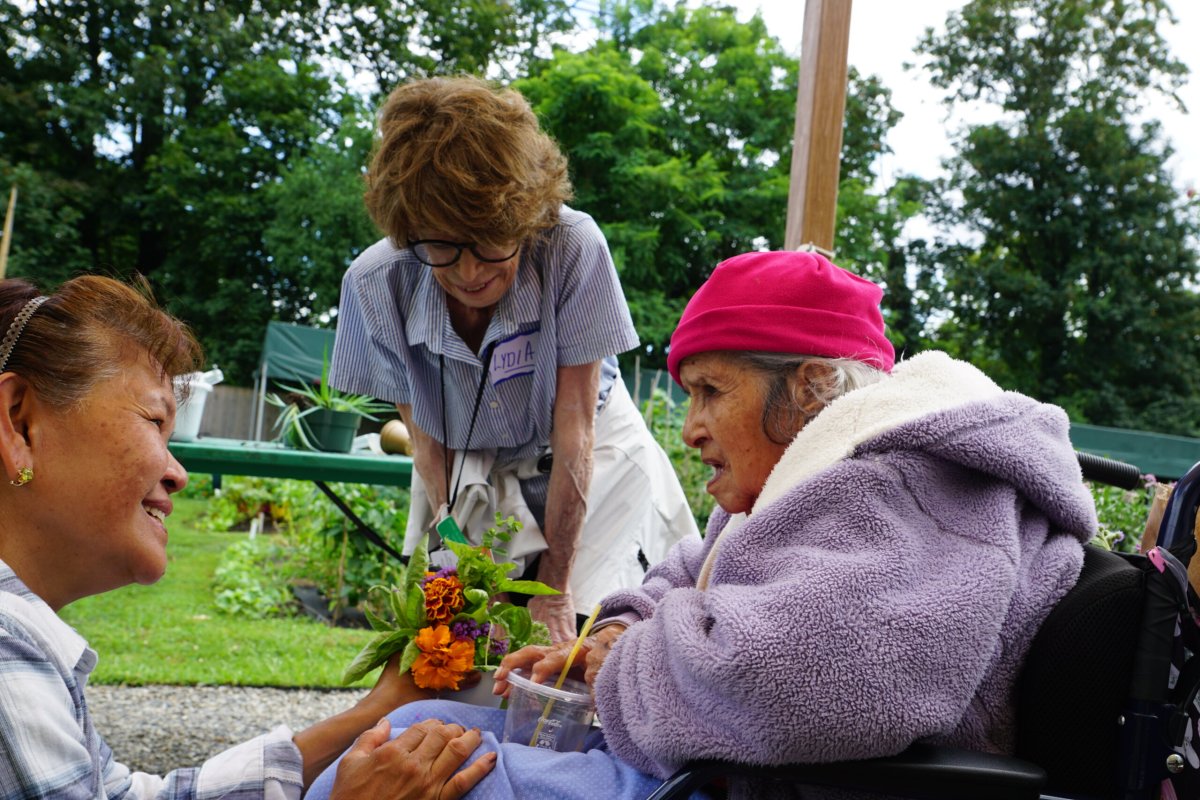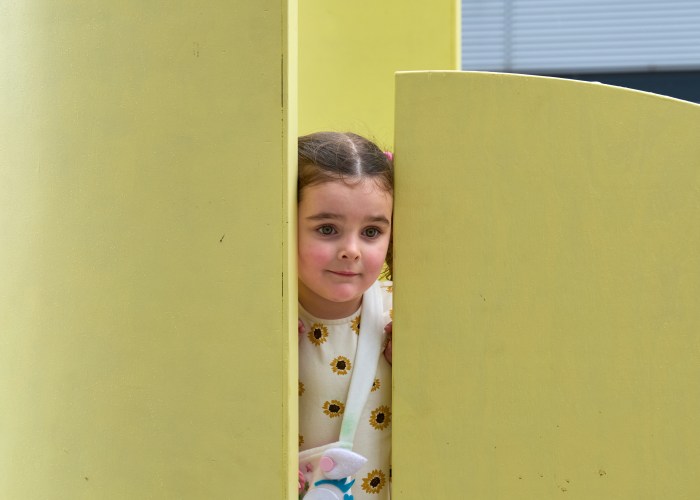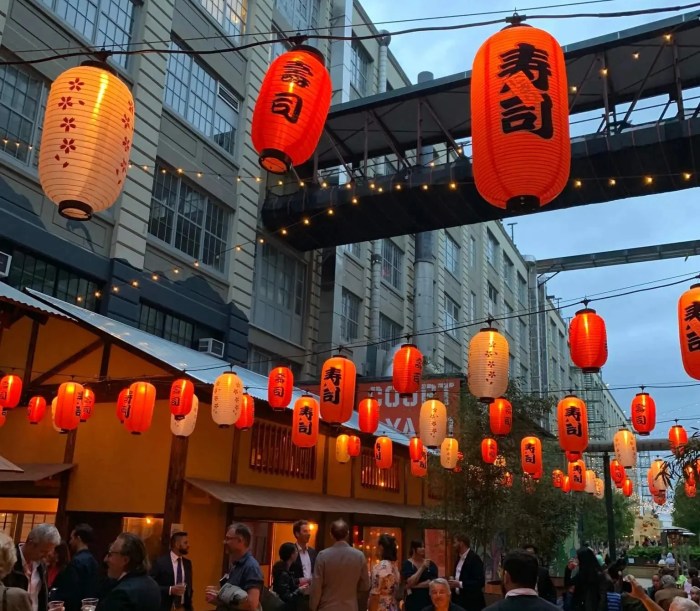On a warm Tuesday morning in August, Joanne D’Auria and her team of volunteers greeted a parade of visitors in the Children’s Garden at the Brooklyn Botanic Garden. Their guests were not kids — though there were children busily tending to the garden that morning – but mostly seniors.
D’Auria and her team are the stewards of the Seasonal Drop-in Memory Program, a monthly offering for people with memory loss and their care partners. That morning, they took attendees on tours through the well-tended beds of the Children’s Garden, poured them small cups of tea to sip, and guided them through the steps of potting up a small aloe plant to take home. A few visitors chose to sit on a bench just outside the garden gates, chatting quietly with each other.
The Drop-In Memory Program was born in 2016, after D’Auria — who had always had a particular interest in working with people with memory loss — earned her certificate in horticultural therapy.
“My mother had Alzheimer’s toward the end of her life, and she was a gardener,” she explained. “And of course, I did all the wrong things 30 years ago, but I was hoping that learning about [gardening,] and how beneficial it could be to people with dementia and their caregivers, that I could offer that program.”
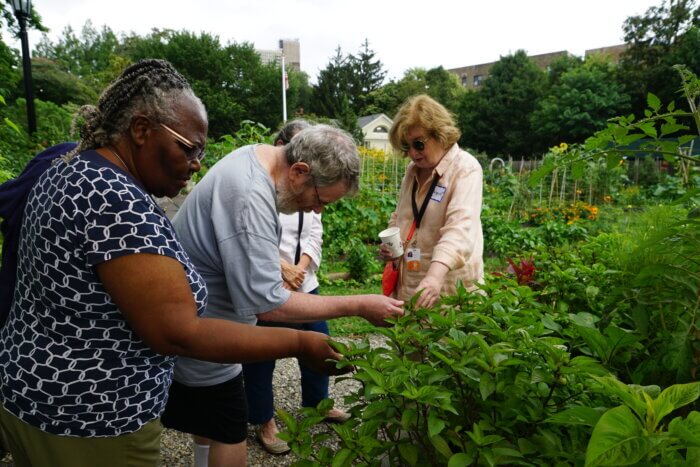
She partnered with CaringKind, an organization that offers advocacy and support for people with Alzheimer’s and dementia in New York City, and launched a pilot program at the garden.
It has evolved over the years as D’Auria learned more about how to manage the program, often applying the lessons she learned when taking care of her own mom.
Last year, at D’Auria’s urging, BBG built raised gardening beds in the Children’s Garden for the memory program, so people could reach the plants and soil without crouching to the ground. The hip-high beds are also the perfect height for wheelchair users. The beds introduced something new to the monthly gathering — they allowed people to plant their own seeds and seedlings and tend to them as they grew, eventually plucking the fully-grown herbs and flowers to display or use in recipes.
It was important for D’Auria that the program have a hands-on element, inviting people to dig in themselves, rather than just enjoying what was planted by others. When her mother’s health declined, and she could no longer go down the steps into her garden, D’Auria got her some window boxes to bring the garden up to the house. At the time, she handled the planting herself, filling the window boxes with flowers and greenery while her mom watched.
Now that she knows more about memory loss, D’Auria said her choice to garden while her mom looked on was “a misstep.”
“And I always think back on that, like, she’s watching me, and I can’t understand why I didn’t take the time to say ‘Mom, here, look, put this plant in here, let’s cover it with dirt, do you want to water it?’” D’Auria said. “She could have done so much more, been really active.”
Some parts of the program, which runs from about May to November, are the same as they’ve always been. Volunteers brewed carafes of hot and iced tea and handed out cookies in between tours, chatting about the garden all the while. The program runs for about 2-and-a-half hours, but it’s a drop-in, so participants don’t have to worry about getting there on time, D’Auria said — whenever they’re ready to get out the door is just fine. Starting in January, D’Auria plans to run the program every month — while the weather is cold, sessions will be hosted in classrooms and the conservatory before heading back out to tour the gardens come March.
As the session wound down that August morning, Karen Binder walked in with her companion, Robin Kang. The two have been working together for just about a year, since Binder’s brother moved away and reached out to a caregiving agency to ensure she would have company and care in his stead.
Kang quickly learned that Binder likes to go for long walks, and reached out to BBG. “What better place to walk?” she said. They visited for the first time in the spring when the garden was a riot of cherry blossom pink, and Binder took to it immediately.
“I grew up in a home with a garden in the back, rose bushes, this and that,” Binder said.
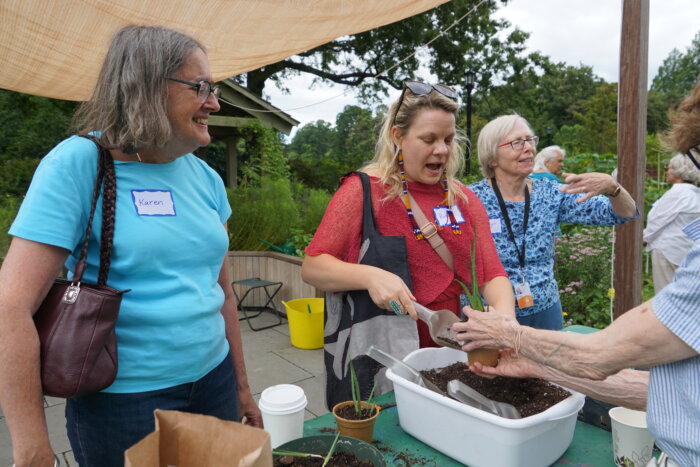
The Children’s Garden, packed in late summer with veggies and sunflowers, brings back memories of her family, her mother — who was a “terrific gardener” — and her life growing up in Midwood.
“My mother and sister would have loved to see this,” she said. “I miss them for a lot of reasons. They would have liked to see this.”
She likes taking home those little potted plants after each session because, she said, they serve as “remnant of our experience.” When Binder isn’t at the Garden, she likes to flip through The New York Times to find things to do during the week, like going to the movies. Retirement has given her time to do things she couldn’t in the middle of her career as a federal lawyer.
“The job only left time for the demands of the job,” Binder said.
But walking around the city with memory loss can be overwhelming and anxiety-inducing, even though she’s spent her life here. The Children’s Garden — and the BBG at large — puts her at ease.
“When you have a kind of dementia, which I guess I do, it can be upsetting,” she said. “You’re aware of it, that you’re not quite the person you once were.”
Brooklyn Afternoons
On that same quiet Tuesday, as people were connecting with nature in the garden, a similar program was gearing up at the Brooklyn Museum, just next door.
The museum is officially closed to the public on Tuesdays — and the uncharacteristic lack of hustle and bustle is the perfect backdrop for Brooklyn Mornings, an interactive tour for people with memory loss and their care partners.
It began in 2012 as Brooklyn Afternoons, explained Allison Day, Senior Manager Family & Community Programs at the Brooklyn Museum. A recent visit from an accessibility consultant changed that, Day explained — they suggested shifting the program up by a few hours to account for “sundowning,” when people with Alzheimer’s disease become agitated or restless in the late afternoon or early evening hours. The museum now offers two memory programs — Brooklyn Mornings in-person on the fourth Tuesday each month, and an online version of Brooklyn Afternoons on the second Tuesday.
Every part of the program — including the time it starts — has been specifically chosen so that it’s safe and comfortable for people with memory loss. Large crowds and loud noises can be distracting at best and physically painful at worst, Day said, particularly for people with traumatic brain injuries. The tour groups are smaller than on standard tours, so everyone can get individual attention, and they move more slowly and carefully through the museum — focusing on maybe just four works of art, rather than the typical ten or 12.

“There’s no need to rush, and, with this audience, rushing is counterproductive … we want everyone to take the time that they need to absorb the art and to engage with the art and with each other,” Day said.
To that end, they also recently added art-making to Brooklyn Mornings.
Many participants say they have been struggling to find adequate programs for their loved ones with memory loss, Day said. In July, they had two new visitors — both of whom found Brooklyn Mornings through CaringKind, the same organization that helped develop the Drop-in Memory Program at BBG.
“For the memory loss participants, it’s great to see other people,” Day said, “A lot of people with memory loss are at home, or in some kind of a care community where the opportunity to go out and be in the community might be much more limited than their lives previously.”
She dreams of someday holding Brooklyn Afternoons in multiple languages. It’s not uncommon for someone with dementia to step back into their first language as they get older, even if they were once fluent in English.
Day said that one former Brooklyn Afternoons participant, over a long stretch of time, spoke more and more in his native French. While Day could exchange basic greetings with him, she is not fluent in French — and neither was anyone else on the staff.
“Ability to communicate is so closely tied with cognitive health. If you cannot communicate, your cognitive health declines faster,” Day said. “For us to connect with each other is one of the most important considerations for this experience.”
Caring for care partners
While the experiences at both the Garden and the Museum are geared towards people with memory loss, both institutions make sure caregivers are welcomed and supported as well.
That is, in part, because the caregiver’s presence is integral to the person with memory loss being able to enjoy the program — even before they arrive.
D’Auria said the caregivers usually fill out the intake form for a new participant, where they answer questions about how and when the person likes to communicate and what they like to do. A care partner recently noted on an intake form that his wife was hard of hearing and asked that program volunteers pause during their conversations with her, giving her a beat to process what they had said and respond.
Some people with memory loss are nonverbal, Day said, and rely on their care partners to act as a microphone. Others may feel comfortable talking with their care partner but not anyone else on the tour.
Day said one regular museum visitor gradually developed aphasia — which impacts a person’s ability to communicate verbally and through the written word — over the course of many months. When he could no longer speak, his care partner could still read his physical language and relay how he was feeling “even if [he] no longer had the words for us,” Day said.
But it’s also important that the caregivers feel seen and cared for on their own.
“The job of being a care partner for anyone is really challenging, but especially for people experiencing memory loss,” Day explained. “Part of it is the progression of memory loss. Part of it is cognitive changes. Everything about the personality is vulnerable to change.”
At the Botanic Garden, D’Auria sometimes offers caregiver-only sessions. The format is nearly identical — participants walk through the garden, plant seeds, and enjoy some refreshments — but the conversation is much different.
“People really need to talk about their experiences, to talk about it with somebody who’s in the same situation while walking through a garden and smelling beautiful things and relaxing and breathing,” she said.
Engaging the senses
Sometimes, D’Auria said, the smell or taste of a plant will evoke a memory – the smell of garlic recently prompted a usually-quiet participant to tell stories about the garden her family had when she was young, and the garlic and tomatoes they grew there and how she shared them with her classmates.
But those memories are bonuses — not the goal, she said.
“I think when we started out that we were hoping that these programs were going to help people remember things,” D’Auria said. “And that’s really not what it’s about, we learned that early on.”
It’s not about fighting against the reality of Alzheimer’s and dementia, but working with it — creating warm and enriching experiences to be enjoyed in the moment.
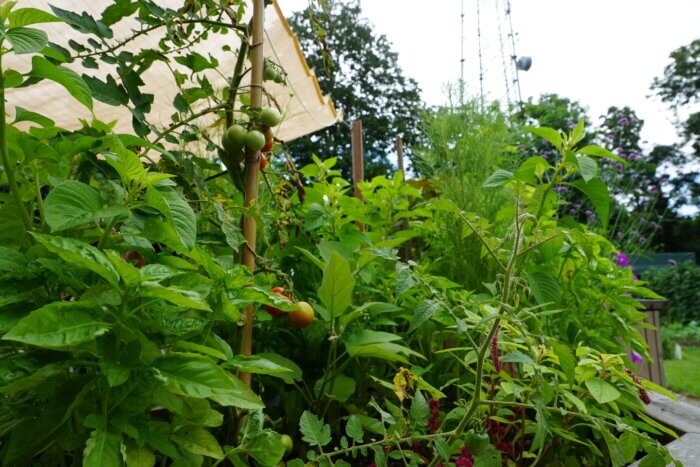
“That changes the conversation. Now we’re not talking about, ‘Do you remember growing this,’ or ‘Do you remember using this,’ it’s really about ‘Feel that texture, that smell, does it smell good to you, or does it smell sweet? Or, ‘That color is so vibrant, would you wear a hat that color?’”
That same warm summer morning, Alicia Peralta sat between the raised beds with her daughter, Sylvia, and two of her care partners. Her companions plucked flowers and herbs from the beds and assembled colorful bouquets to show off to Alicia before tucking them away in pockets and bags to take home.
At 92, Alicia has been living with memory loss for about three years, and is mostly nonverbal. She started attending the Drop-In Program about a year and a half ago.
“She always loved the garden, now she can still come and participate even though it looks like she’s not,” Sylvia said, explaining that even though her mother is often quiet and sometimes sits with her eyes shut, she’s still taking everything in — and loves taking home new flowers at the end of each session. “She used to have — well, she still has — a room full of plants that we take care of. She used to plant her own things in a room inside the house.”
Some days, depending on how she feels, Alicia is up for a little flower arranging herself, Sylvia said. But even when she isn’t, the garden offers warm sunshine, the earthy fragrance of plants and herbs, and the soft sounds of birdsong and people chatting. Engaging the senses is critical for helping to connect with people with memory loss. D’Auria said the team specifically chooses plants for the Children’s Garden that offer some sensory experience — be it smell, touch or even taste.
In August, the air was filled with the smell of the basil overflowing from the raised beds, which were also packed with colorful flowers and tiny, bright-red tomatoes. The aloe plants set out on a table for participants to pot and take home played to the sense of touch, with their spiny, tough exteriors and cold and gooey insides.
Lydia Bryan, a volunteer at the garden, offered Alicia a taste of a bright-orange edible flower — which she took happily, with the help of one of her care partners.
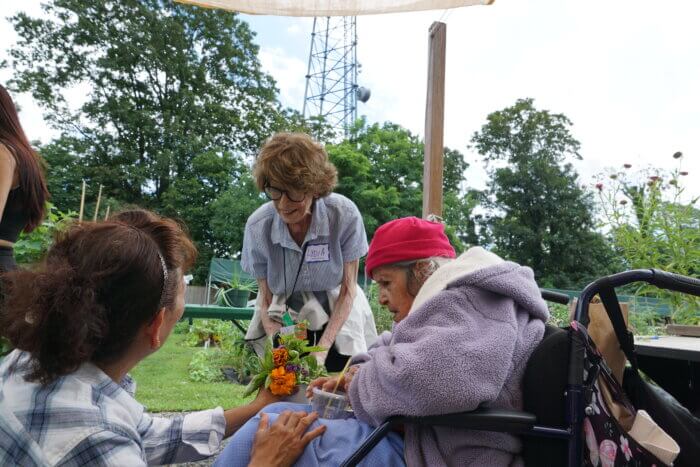
At the museum, the senses also take center stage.
When a group is looking at a portrait, Day or one of the teaching artists who run Brooklyn Afternoons might pass around a piece of fabric similar to the dress worn by the subject of the painting. They play music from the time period of certain pieces, and even use items like scented lotion to really immerse the group in the art.
“It’s an incredible experience to be with people who are responding very much in the moment to the art that’s there, and, of course, we want people to connect to art but also to each other,” Day said. “Where the very most impactful teaching happens is when we can connect these experiences together.”
More than memories
Day and D’Auria both know the people they see at their programs may not remember what they talked about the next day, or who they spoke with. But that’s also not the point.
Brooklyn Afternoons is, ultimately, meant to be respite, Day said, a way to allow people with memory loss to feel safe and comfortable at the museum.
Day recalled a conversation she had last summer with a new participant who had recently been diagnosed with early-onset Alzheimer’s.
“She said, I loved this so much, and I really hope to come again … but I’m worried that I won’t remember you next time,” Day said. “And I said, ‘Don’t worry about that, you are always welcome. There’s nothing about this experience that you need to remember from one time to the next. Hopefully, what will last is that when you think of the Brooklyn Museum, that you think of it as a place that you are comfortable to be.’”
“She said, ‘That sounds great, I think that’s likely to happen.’”
Editor’s Note: This story was published in memory of Alicia Peralta, who passed away on Nov. 14, 2023.
Correction, 12/11/2023, 12:11 p.m.: This story previously referred to CaringKind as a branch of the Alzheimer’s Association. CaringKind became an independent organization in 2016. We regret the error.


